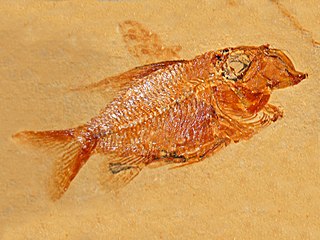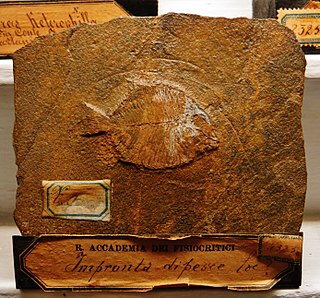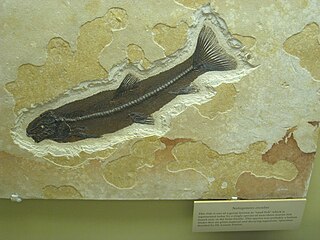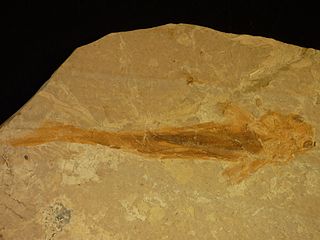Spathiurus is an extinct genus of prehistoric ray-finned fish that lived during the Cenomanian in the Sannine Formation of Lebanon.

Lissoberyx is an extinct genus of prehistoric ray-finned fish belongon to the family Trachichthyidae. Lissoberyx is a trachichthyid, but it shows more resemblance to the holocentrids than any other trachichthyid.
Macrepistius is an extinct genus of prehistoric ray-finned fish that lived during the Albian stage of the Early Cretaceous epoch.
Casierius is an extinct genus of marine ray-finned fish that lived during the Albian stage of the Early Cretaceous epoch. It was a relative of the modern bonefish in the extinct family Phyllodontidae, although some authorities consider it either a true albulid or a very early eel. It contains a single species, C. heckeli, known from the Glen Rose Formation near Hood County, Texas.
Grypodon is an extinct genus of prehistoric ray-finned fish that lived during the Late Cretaceous epoch.
Polygyrodus is an extinct genus of prehistoric ray-finned fish that lived during the Late Cretaceous epoch. The name is a combination of the Greek words poly (many), gyro (round), and odoy (tooth).
Stromerichthys is an extinct genus of prehistoric ray-finned fish that lived during the Late Cretaceous epoch.

Stemmatodus is an extinct genus of prehistoric ray-finned fish that lived in Europe during the Early Cretaceous approximately 129 to 125 million years ago.
Mesoclupea showchangensis is an extinct ichthyodectiform ray-finned fish that lived in freshwater environments in what is now China during the Early Cretaceous epoch. It differs from its sister genus, Chuhsiungichthys, primarily by having a more posteriorly-placed dorsal fin.
Petalopteryx is an extinct genus of prehistoric ray-finned fish that lived during the Early Cretaceous epoch.
Neorhombolepis is an extinct genus of prehistoric ray-finned fish that lived during the Early Cretaceous epoch.
Stichopterus is an extinct genus of chondrostean ray-finned fish that lived during the Early Cretaceous epoch in Asia. It has been found in Russia and Mongolia.
Urenchelys is an extinct genus of prehistoric bony fish. This genus is interesting as comprising the oldest known eels, which differ from all the tertiary and existing eels in still retaining the caudal fin.

Notogoneus is an extinct genus of prehistoric ray-finned fish. A trace fossil attributed to Notogoneus osculus has been found in the Green River Formation.
Nybelinoides is an extinct genus of prehistoric ray-finned fish from the Early Cretaceous.

Osmeroides is an extinct genus of prehistoric ray-finned fish from the Cretaceous.
Pleuropholis is an extinct genus of prehistoric ray-finned fish.

Peipiaosteus is an extinct genus of prehistoric chondrostean ray-finned fish. Its fossils are found in the Early Cretaceous Jiufotang Formation, Pani Lake, Liaoning Province, China.

Morrolepis is an extinct genus of prehistoric coccolepidid "palaeoniscoid" ray-finned fish that lived during the Late Jurassic and earliest Cretaceous epochs in Europe, Asia and North America.
Chuhsiungichthys is an extinct genus of ichthyodectiform ray-finned fish that lived in freshwater environments in what is now Yunnan, China, and Kyushu, Japan during the Cretaceous. It differs from its sister genus, Mesoclupea, primarily by having a comparatively more anteriorly-placed dorsal fin.





